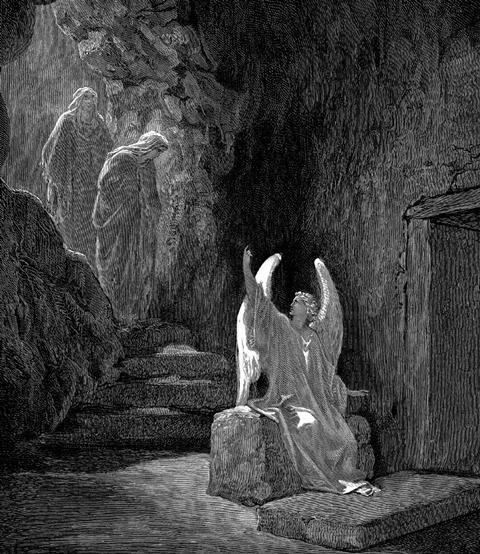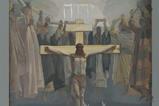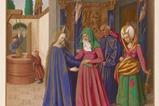Elaine Storkey shares how she approached writing her latest book, Meeting God in Matthew (SPCK). In doing so, she provides tips for readers’ own close study of the Bible.

As a child, the children’s section of the town’s public library was one of my favourite places. I was not simply in the company of books and their fascinating, whimsical characters, I was also in the company of authors. Growing up with skilful wordsmiths, getting to know their voices and hearing their stories week after week enriched my childhood.
It’s probably not surprising that I was so attached to books. I come from a family of storytellers. My grandparents, parents, uncles and aunts were all narrators of one kind or another. As a young child I would creep back on to the stairs after bedtime, and listen to adult talk as visiting relatives recounted details of their everyday lives to each other. The pictures and narratives they wove were colourful, graphic and absorbing. And I was there, right inside their stories.
National public events were brought to life too. My grandmother was old enough to remember in detail the death of Queen Victoria and the Coronation of Edward VII. Not that she witnessed them physically, of course, or saw anything of those events. Those were days before the internet, mobile phones, television or even national radio. Telegraph wires near Osborn House on the Isle of Wight, where Queen Victoria stayed in her final days, allowed hourly news bulletins to be telegraphed to newspaper editors who published them to the nation. My grandmother remembered the scramble on the streets for the freshly released papers.
The written word has therefore always been strongly linked with the spoken word for me. And this has been a great help in understanding the Bible. For the Bible is a collection of books comprising many different kinds of literature – law, proverbs, prophecy, history, biography, etc. Often, you can hear the author telling the story, as in the Book of Ruth or Esther, or speaking personally, as in the Psalms and letters.
Sometimes the author is focused on a specific issue, as in relating the tragic events in the life of Job and his eventual reward. Sometimes we are being instructed, as in Paul’s epistles. But when we hear the voice of God speaking through the human author, we experience a powerful connection of heart, mind and spirit and are drawn more deeply into God’s love.
Unpacking the message of Matthew’s Gospel
When I was asked to write a book for today on one of the Gospels it was a delight but also a challenge. Writing a book about a book is quite an intricate task, especially when that book is the Gospel of Matthew. Several questions faced me from the beginning.
Who was the author and when was it written? I soon accepted that although Matthew’s Gospel comes first in the New Testament, it was almost certainly written after Mark’s. I also discovered that people date it differently, often depending on their theology! It probably wasn’t written down by Matthew himself, yet he most likely played a large part in passing on the stories in the book.
After lots of research, I decided to give the benefit of the doubt to those scholars who argue for an early dating – some time between 68 AD and 83 AD. Jesus’ prediction of calamities and destruction fits the carnage and horrific bloodbath following the Jewish Revolt against the Romans from 66-70 AD and the siege of Jerusalem. And that dating seemed to make more sense of other incidents Matthew included and conversations that Jesus had.
Who was the book written for? On the big scale, God obviously intended it for the whole of history, not just for one set of first-century readers. Anyone who reads Matthew’s Gospel comes face to face with Jesus and Matthew’s claim that he is the Anointed One, the Saviour of the world. But who were the ones who first read the message of the evangelist? And why was it given to them?
The text itself gives us many clues. Matthew was writing for Jewish converts to the Christian faith and to those Jews not yet decided. New followers of Christ often faced conflict and persecution from traditionalist Jewish leaders, who saw them as traitors to their cause. We read as much, in the warnings Jesus gave to his disciples about trials and persecutions they would face, and those who would come after them.
Sometimes we can even hear, in his language, Matthew denouncing hypocrisy, the anger at the injustice and violence his fellow-believers will suffer; he’s the only Gospel writer who includes Jesus’ descriptions of his ruthless enemies as a “brood of vipers” (12:34) and “whitewashed tombs” (23:27). Matthew’s aim was to set the record straight and encourage those who believe to hold fast to their faith.
How did Matthew structure his account? I marvelled at the clever way he chose to tell the story, in terms of themes and periods of Jesus’ life and ministry. He breaks his narrative up often by a single phrase “from that time on, Jesus began to…” He punctuates it with prophecy and references back to the Hebrew scriptures. He wraps his account around two big statements of God’s presence in human life: “Immanuel, (which means ‘God with us’)”, which comes in the nativity at the beginning (1:22) and “I am with you always, to the very end of the age”, which closes the book (28:20). The way Matthew structures his Gospel might well be a useful lesson in any creative writing class.
I found Matthew was not predictable, however. Rather than starting, like Luke, with the gripping, dynamic story of the nativity, he began his account with a long genealogy of obscure names. Yet this was written for one specific purpose: to give Jesus’ Jewish Messianic credentials to those who need to know. This tells us that Jesus was descended from Abraham, in the line of Judah and David, King of the Jews. His heritage perfectly fit the prophecies of the coming of the Messiah. Yet even in the genealogy, there are surprises for us. We find some very unholy people there! Jesus was sin-free – despite the waywardness of some of his ancestors.

Trusting the author
Travelling in close company with Matthew through the life of Jesus has been wonderful. As I visited Jesus’ birth, his preparation for ministry, his preaching and miracles, his move from Galilee to Jerusalem, his arrest, trial and execution, I let Matthew’s voice guide me through his powerful text. I knew this was an author I could trust. Matthew showed me that Jesus understood what he would go through when he arrived in Jerusalem. He knew the weakness of his disciples; he knew the opposition and lies that would be told against him; he saw the cross on the horizon. And I recognised why Matthew would give so much space to the final week of Jesus’ life.
For we, too, need to understand how the combination of religious hypocrisy, envy, hatred, injustice, betrayal for money and the military might of the Roman empire would bring Jesus to the point of death. I shuddered as Matthew took us back to Psalm 22 and Jesus’ cry on the cross: “My God, My God, why have you forsaken me?” (27:46). Matthew wants us to know beyond doubt that Jesus was bearing the sins of the world and that he alone could do this.
I found it so uplifting that as Matthew ended the story with Jesus’ glorious resurrection, he focused on a group of faithful women. He pinpointed many women in his narrative, but these women who had loved Jesus and stood by him were now given a supreme task. They themselves didn’t really understand what that task was; they’d been in grief for two days, preparing spices and worrying about the tombstone. They thought they were going to anoint the body of a corpse. But Matthew knew the task they had been selected for and spelt it out for us (28:1-10). They were to meet the risen Jesus and be made witnesses to the fact that he was alive.
They were given the good news to spread to his disciples and beyond, ultimately to the ends of the world. Matthew completed his account with the great commission and the promise given to those who believe in Jesus. Christ will indeed be with us, to the very end of time itself.
Writers live with great responsibilities and privileges. Books have to be worth the energy needed to write them. The author has to engage with their readers and go on a journey with them. My journey with Matthew was inspirational, yet it was not unique. It was one made by millions of other readers throughout history who have discovered that Matthew was faithfully passing on to us the word of life. My privilege was to be allowed to share that journey in a book of my own.


































No comments yet